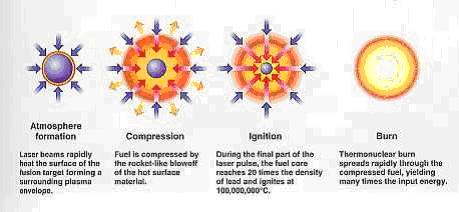Ø Inertia Confinement
Inertia confinement involves the use of very high power beams (particle or laser) to compress and heat the fuel pellet to the point of fusion. The rapid heating caused the outer layer of the target to explode outward, producing a reaction force against the remainder of the target, accelerating it inwards in a rocket-like implosion. The implosion causes compression of the fuel inside the capsule and formation of a shock wave, which further heats the fuel in the very center and results in a self-sustaining burn known as ignition. The fusion burn propagates outward through the cooler, outer regions of the capsule much more rapidly than the capsule can expand. In essence, the plasma is confined by the inertia of its own mass.

Source: http://www.iter.org/a/index_nav_2.htm
Typical fuel pellets are about the size of a pinhead and contain around 10 milligrams of fuel: in practice, only a small proportion of this fuel will undergo fusion, but if all this fuel were consumed it would release the energy equivalent to burning a barrel of oil.
The beams can be applied directly (the “direct drive” mode) onto the target pellet. Alternatively in the ‘indirect drive’ mode, the beams can be used to heat the inner walls of a gold cavity called a hohlraum containing the pellet, creating a superhot plasma which radiates a uniform "bath" of soft X-rays. The X-rays rapidly heat the outer surface of the fuel pellet, causing a high-speed ablation, or "blowoff," of the surface material and imploding the fuel capsule in the same way as if it had been hit with the beams directly.

Source: https://lasers.llnl.gov/programs/nic/icf/how_icf_works.php
In the “fast-ignition” approach, the pellet is firstly compressed to a density hundreds or thousands times of the density of solid materials, then a short (one billionths of a second), ultra-intense (~1015 Watts) laser pulse is injected to further heat and ignite the ultra-high density plasma. This approach allows separate optimization of the high-density implosion and the heating process to achieve a greater efficiency and yield of fusion reactions.

Source: http://www.ile.osaka-u.ac.jp/zone3/explanation/what/index_e.html